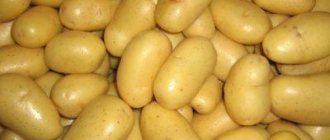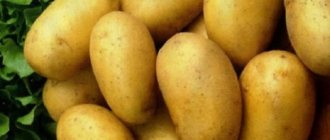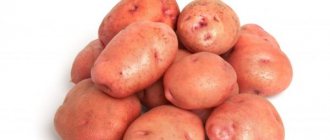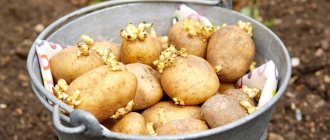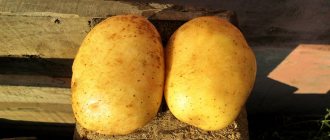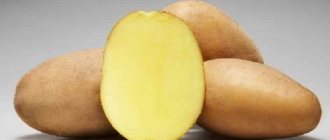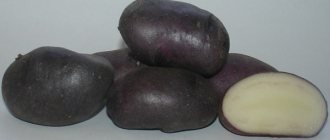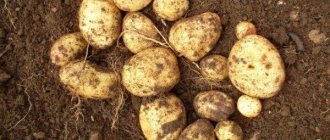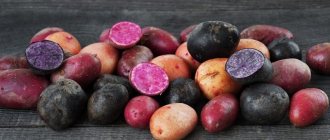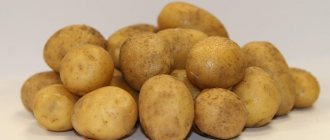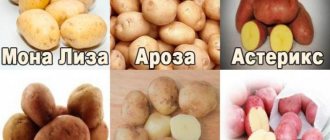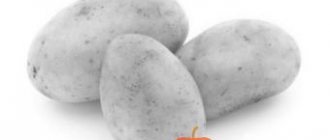Description of the potato variety Jewel
Potatoes Jewel (Yuvel) are a German super-early variety, characterized by high yield and good taste. Developed by specialists from Bavaria-Saat Vertriebs GmbH. It has not been tested in Russia, so it is not included in the register of breeding achievements. However, some summer residents have already tried to grow crops in different regions:
- middle lane;
- Northwest;
- southern regions.
According to reviews, Jewel potatoes take root well in different climatic conditions of Russia. Main characteristics of the variety:
- table (mass fraction of starch 10-15%);
- early ripening (technical ripeness after 50 days, highest yield after 70 days);
- medium height (50-60 cm).
Jewel potato bushes are somewhat prone to bending; they are moderately spreading and densely leafy. The leaves are deep green in color and have a typical shape and size. The corollas are large, light purple in color, and the inflorescences are compact.
The tubers are elongated oval in shape, with yellow skin and pulp. They are quite large in size - 5-8 cm or more in length, weight 80-150 g. They are very attractive in appearance: the surface is even, smooth, with a pleasant gloss, the eyes are invisible.
The pulp is practically not overcooked and holds its shape well. The taste is rich, delicate, not watery. At the same time, Jewel potatoes do not darken when cut even after heat treatment or freezing.
Potato Jewell produces large, marketable root crops
Originator
The main originator of the Jewel potato variety is Bavaria-Saat GbR. It immediately unites several companies involved in developing the latest potato varieties. But still not the legal owner of the patent. At the beginning of 2003, a partnership was founded within this company under the name Bavaria-Saat Vertriebs GmbH. It was also involved in the sale of seed material abroad and in Germany. Thanks to the very successful and prosperous activities of this organization, Jewell potatoes began to gain great popularity in Europe, but also in our country, Ukraine, Belarus, etc.
Description
Jewel seed potatoes have the following characteristics:
- The bushes are of medium height, very dense, and practically not prone to lodging. Tubers begin to form quite quickly, the flowers have a dark purple hue.
- The tubers are oval in shape, the eyes on the potatoes are not deepened, superficial, the skin is without roughness, smooth. The color of the peel is light yellow, the pulp of the root vegetable is one tone lighter than the peel.
- Excellent resistance of the variety to various diseases - late blight, scab, and rotting.
- Potato yield - with an early harvest, you can collect an average of up to 450 centners per hectare. At a late date - up to 750 centners per hectare.
- Potatoes of the Jewel variety are very tasty, not crumbly, the starch content is from 11 to 13 percent, the vegetables are even, usually the same size, the percentage of low-quality tubers is not very high.
Advantages and disadvantages
If you have come across this publication, then you are probably wondering what the pros and cons of early Jewel potatoes are. We have already written above the two main advantages of the Jewel variety - early ripening and high yield.
- From just one kut of this potato variety you can get from ten to twenty root vegetables. As for potato growing companies, they receive no less than 750-800 centners per hectare if all necessary technical conditions for cultivation are met.
- Early dates 9 growing season (51-65 days). They are profitable and attractive because on fertile soil in a warm climate, you can grow 2 vegetable crops in one season on one plot.
- Potatoes of the Jewel variety have an excellent presentation: almost all tubers are the same size, smooth, and the eyes do not lie deep.
- During transportation, potato tubers of the Jewel variety are perfectly preserved, they have excellent resistance to minor damage, and the wounds dry out quite quickly, without becoming infected with fungal diseases that can cause rotting.
The main disadvantage for vegetable growers is the fact that the Jewel variety requires good soil moisture. It needs additional watering during dry periods. If you can meet this requirement, you can get a rich harvest. As for very dry soil, tubers simply stop growing in it. And this circumstance results in a loss among the masses.
https://youtube.com/watch?v=Pruyf4UClB0
Characteristics of the potato variety Jewel
The Jewel potato variety is unpretentious and tolerates short-term drought and even light frosts. However, it is better to plant tubers in mid-May to avoid too sharp a drop in air temperature in the squat layer. The shelf life index is quite high - up to 94%. Root crops can be transported over long distances. The scope is universal: for cooking, frying, stewing, fries and chips. Jewel potatoes are well suited for soups, salads and main courses.
Productivity
Jewel potatoes ripen very early - the first digging can be done already 1.4 months after germination, that is, in early July. On average, each bush produces 10-15 large tubers, maximum 20. Yield indicators are very high:
- 1.2-1.8 kg from 1 bush;
- 4.5-6.5 kg per 1 m2;
- 450-650 kg per 1 hundred square meters.
There is evidence of record yields of up to 700 kg per hundred square meters. Similar indicators can be achieved when growing crops in the climatic conditions of the middle zone and the Black Earth Region, in fertile and light soils. To make the tubers as large as possible, you should follow the basic growing rules:
- watering in hot weather;
- hilling and fertilizing 2-3 times per season;
- regular weeding and loosening;
- prevention of late blight and other diseases.
Advantages and disadvantages
Jewel potatoes are widespread in Russia due to their very pleasant taste and really high yields. This is an undemanding crop that can be grown in the climatic conditions of most regions of the country.
Potato Jewel shows yield records of up to 600-700 kg per hundred square meters
pros
- very high yield;
- early ripening;
- good, pleasant taste;
- drought resistance;
- immunity to late blight on tubers and other diseases;
- low maintenance requirements;
- good keeping quality and transportability;
- attractive appearance.
Minuses
- weakly resistant to late blight on tops;
- yield depends on weather conditions;
- Lack of hydration affects the taste.
Advantages and disadvantages
Among the main advantages of the variety:
- excellent taste;
- high productivity;
- very early maturation;
- the tubers are smooth, oval, ideal for sale;
- universal potatoes, suitable for frying or boiling;
- tubers are well stored;
- drought resistance;
- the variety tolerates heat and short-term frosts;
- resistance to major diseases.
Disadvantages include sensitivity to watering . With a constant lack of moisture, the tubers become smaller and the number of ovaries under the bush decreases.
During frequent rains, the potatoes turn out larger, but their taste becomes watery.
Below in the table you can see the comparative characteristics of the marketable weight of tubers and their keeping quality for other very early varieties:
| Variety name | Weight of marketable tubers (grams) | Keeping quality |
| Farmer | 90-110 | 95% |
| Meteor | 100-150 | 95% |
| Minerva | 120-245 | 94% |
| Kiranda | 92-175 | 95% |
| Karatop | 60-100 | 97% |
| Veneta | 67-95 | 87% |
| Zhukovsky early | 100-120 | 92-96% |
| Riviera | 100-180 | 94% |
Landing rules
Jewel potatoes are grown on fertile, light soils with a slightly acidic or neutral reaction. The optimal type of soil is sandy loam. If the soil is clayey or heavy, it must be prepared by adding 500-700 g of sand or sawdust per square meter. Also, the soil should be fertilized with compost or humus (3-7 kg per 1 m2). All this work is carried out simultaneously with digging the day before in the fall. If the deadlines are missed, you can make it in early April.
Advice! To plant potatoes, you should choose well-lit, level and dry areas. They should not have strong slopes where moisture accumulates - otherwise the yield may sharply decrease.
A month before planting, Jewel potato tubers are sorted and laid out in the light in a cool room (temperature 13-16 degrees). They are periodically sprayed, and on the day of planting they are pickled in a 1% solution of potassium permanganate or using fungicides: “Fitosporin”, “Hom” and others. You can also treat it with growth stimulants - Epin, Zircon.
Sprouted Jewell potatoes are ready for planting
Jewel potatoes can withstand light frosts, so in the middle zone and especially in the southern regions, tubers can be planted at the end of April. In the North-West, the Urals and Siberia, the dates shift closer to mid-May. The main criterion is that the soil temperature must have time to warm up to 10 degrees or higher, which is easy to check by burying a thermometer to a depth of 10 cm and holding it there for 15 minutes.
The Jewell potato planting scheme is standard:
- Form several furrows at intervals of 70 cm. Orient in direction from north to south.
- Make holes 5-10 cm deep (the lighter the soil, the smaller).
- Place the tubers at a distance of 25-30 cm from each other.
- Dust with ash and cover with soil.
How to plant and grow Juwel potatoes
Gardeners who want to achieve a record harvest carry out a number of manipulations with the seed:
- all sown root crops stored in cellars and other cold and dark places are brought out into the light and into the heat;
- sort through the tubers and remove spoiled ones;
- disinfect the seed with a solution of boric acid (0.2 g of acid per 1 liter of water).
Seed material is selected during the harvesting process. Before stashing the seeds in the cellar for long-term storage, they need to be “greened” - kept in a well-lit place for a week, not forgetting to turn them over periodically. This way the tubers will be better preserved and protected from rats and mice.
For planting, tubers are selected whose dimensions do not exceed the size of a chicken egg. Seed material is disinfected with a weak solution of potassium permanganate or saltpeter. To speed up the development of root crops, potatoes are sprouted: left in a warm place for three or four weeks. Unsprouted planting material is thrown away.
Yuvel is a potato variety that can adapt to any type of soil. As practice shows, the best harvest can be harvested from well-fertilized and moderately moist land.
Soil preparation begins in the fall. Winter crops are planted in beds intended for Jewel potato varieties. In spring, the sprouts of winter crops are removed, and organic fertilizers are added to the soil. After this, surface loosening of the soil is carried out to a depth of about 30 cm.
Planting Jewel potatoes requires preliminary site preparation
Tubers are planted in mid-April or early May. In northern Russia, the landing takes place a few days later. You can plant tubers even if the soil has not warmed up enough, since Jewel is resistant to temperature vagaries.
If the soil is sandy and light, potatoes are deepened by 10 cm. When planting in heavy soil, the planting depth must be reduced by about half. Experienced vegetable growers, before planting planting material in open ground, dust it with wood ash. It contains large amounts of nitrogen and potassium. Thanks to the presence of these substances, the plant develops faster.
Having finished planting, the ground is leveled and left undisturbed until the first shoots appear.
Planting potatoes can be done in several ways. The easiest ones are smooth or trench. The smoothest method of planting is the least labor-intensive. Among gardeners, it has another name - planting under a shovel.
First, holes are dug in the soil, and fertilizers are placed in each of them (some vegetable growers use superphosphates). Having laid out the potatoes in the holes and pressed them inward, they are covered. If the soil is abundant in moisture, the seed does not need to be watered.
Planting in open ground using the trench method is carried out as follows:
- Furrows are made in the soil, the distance between which is 50–70 cm.
- Jewel potatoes are planted in furrows at a depth of 20 cm and positioned so that the distance between tubers is 25–30 cm.
Features of cultivation
The Jewel variety is unpretentious. However, to improve taste and get a good harvest, you must follow the basic growing rules:
- Regular watering in hot weather - at least once a week (a bucket for 2-3 bushes). If possible, it is better to use a drip irrigation system.
- Hilling - 2-3 times per season: after the tops reach 15 cm, then at intervals of two weeks.
- Fertilizing with complex mineral fertilizer or organic matter (infusion of manure) also 2-3 times per season (before hilling).
- Loosening is regular: twice a month, especially after watering and rain.
- Weeding by hand or with a hoe - as needed.
Pests and diseases
Jewel potato has good immunity to canker, golden nematode and common scab, and average resistance to late blight on tubers. However, late blight on the tops is often observed, although thanks to the early stages the variety may have time to “escape” the infection. At the same time, in reviews, summer residents sometimes write that plants can suffer massively from both this disease and Alternaria.
Therefore, it is extremely important to carry out preventive measures - these are simple actions that will minimize the risk of diseases and pest invasions:
- Change the planting site every 3 years.
- Do not sow Jewel potatoes where other Solanaceae grew last season - tomatoes, eggplants, any varieties of potatoes, peppers.
- Treat the tubers before planting.
- Apply a single fungicide treatment after the tops grow to 15-20 cm.
- To combat insects, use folk remedies and insecticides.
Preventive measures will help protect Jewel potatoes from late blight and other dangerous diseases
There are a lot of preparations for the prevention of potato diseases - for example, among fungicides the following are particularly effective:
- "Home";
- "Prestige";
- "Quadris";
- "Fitosporin";
- copper sulfate;
- Bordeaux mixture.
To combat aphids, Colorado potato beetles, click beetles, mole crickets, wireworms and other pests, insecticides are used:
- "Biotlin";
- "Colorado";
- "Spark";
- "Decis";
- "Fitoverm";
- "Agravertine".
You can also prevent pest infestations using folk remedies. For example, in dry and windless weather, you should dust the bushes with ash. The plantings are mulched with straw, fresh sawdust is placed between the rows, and a weak tar solution is periodically poured. The bushes can be treated with a decoction of marigolds, an infusion of chili peppers, mustard, and garlic cloves. If possible, coriander, fragrant tobacco, calendula and other fragrant plants are planted near the Jewell potato field.
Advice! If possible, it is better to plant Jewel potato varieties and any other variety in fields where any root crops, winter grains, legumes or cucumbers previously grew.
Diseases
Struggle
Diseases that can affect tubers:
- fungi - in conditions of thickened plantings, waterlogging of the soil, non-compliance with crop rotation, violation of planting technology;
- late blight - with dense crops, replanting in mid-summer.
The main pests of the Jewel variety:
- Colorado potato beetles;
- nutcrackers.
Important!
An effective method of pest control is manual collection from the beds. In critical cases - spraying with insecticides. Spraying plantings with Fitosporin during the growing season can help in the fight against fungal diseases.
Folk remedies for late blight include the following methods of control:
- Treatment with infusion of garlic and potassium permanganate. Grind 100 g of garlic, add water (1 glass), leave for 24 hours, mix with a solution of potassium permanganate (1 g of substance per 10 liters of water). Spraying is carried out every 2 weeks. 0.5 liters are consumed per bush.
- Spraying with sour milk whey diluted with water (ratio 1 to 1). The procedure has been carried out every 2 weeks since July.
- Processing with wood ash.
- Watering with yeast. 100 g of the substance are stirred in 10 liters of water. The product is used at the first signs of late blight disease.
Prevention
As a preventive measure against fungal infections, tubers are treated with a disinfectant solution of potassium permanganate or boron before planting and must be dried. Be sure to maintain an interval between crops when sowing to avoid overcrowding. Remove affected tubers from the area.
Crop rotation is taken into account. To protect potatoes from pests, before planting, areas are sown with phacelia, oilseed radish, and legumes.
Harvesting and storage
Jewell potatoes can be harvested twice:
- 45 days after germination.
- 60-70 days after germination.
The last digging is carried out in mid-July, after which the second crop rotation can begin. In two weeks, it is advisable to mow the tops to a height of 10 cm so that the tubers gain mass. Jewell potatoes are traditionally harvested on a dry and warm day. The tubers are laid out on the ground to dry, then put into bags and stored in a dark room. The first two weeks maintain the temperature at 14-15 degrees, then in the range of 2-4 degrees, the humidity level is 70-80%.
Potatoes can be stored in bags or wooden boxes
Attention! It is better to consume the largest and smallest Jewel potato tubers first, and the remaining root vegetables can be sent for long-term storage.
Potato care
The variety has its own cultivation characteristics, neglect of which will lead to a shortage of harvest. For Jewel potatoes, watering is of great importance, especially in areas with risky farming, where periods of drought can be very long. In addition, systematic enrichment of the soil with macro- and microelements helps ensure high productivity.
Watering
Moist (but not waterlogged) soil contributes to the realization of the potential declared by the originators. Under such conditions, tubers develop to their maximum size. The optimal method of irrigation is drip irrigation, in which there is no risk of moisture stagnation. If it is not possible to organize it, pour water under the root twice a week. During periods of drought, the frequency of water procedures is increased up to three times.
Soil treatment
To maintain looseness, the soil is loosened after each watering or precipitation, while simultaneously weeding out weeds that deplete food and moisture reserves. To make the latter evaporate more slowly, the beds are mulched. The variety is low-growing, so it develops well even without hilling. However, to improve aeration and protect tubers from overheating, the procedure can be carried out.
Top dressing
During the growing season, fertilizers are applied three times. To consolidate the effect, you can also carry out foliar feeding based on 1 g of boric acid and 1 liter of water. Main stages:
- After sprouting, the potatoes are watered with a fertilizer solution prepared from ½ liter of bird droppings infusion, 30 g of urea per bucket of water.
- During the budding phase, 50 g of superphosphate and 200 ml of dung infusion are used for a similar volume of liquid.
- After active flowering begins, the previous fertilizing is repeated, adding a little potash fertilizer.
How to plant potatoes correctly to get a good harvest?
Protection from diseases and pests
If agricultural cultivation practices are violated or in cool spring conditions, manifestations of top blight in the form of brown spots are observed on the shoots. To protect the plantings, you should immediately spray the bushes with a solution of copper sulfate or Bordeaux mixture. Potatoes are also attacked by wireworms, Colorado potato beetles and mole crickets. An insecticidal disinfectant is effective against the first soil-dwelling pest. Spraying on the leaves will help control the Colorado potato beetle. But only baits are effective against mole crickets.
For your information! 20 days before harvesting, spraying of plantings with pesticides is stopped.
